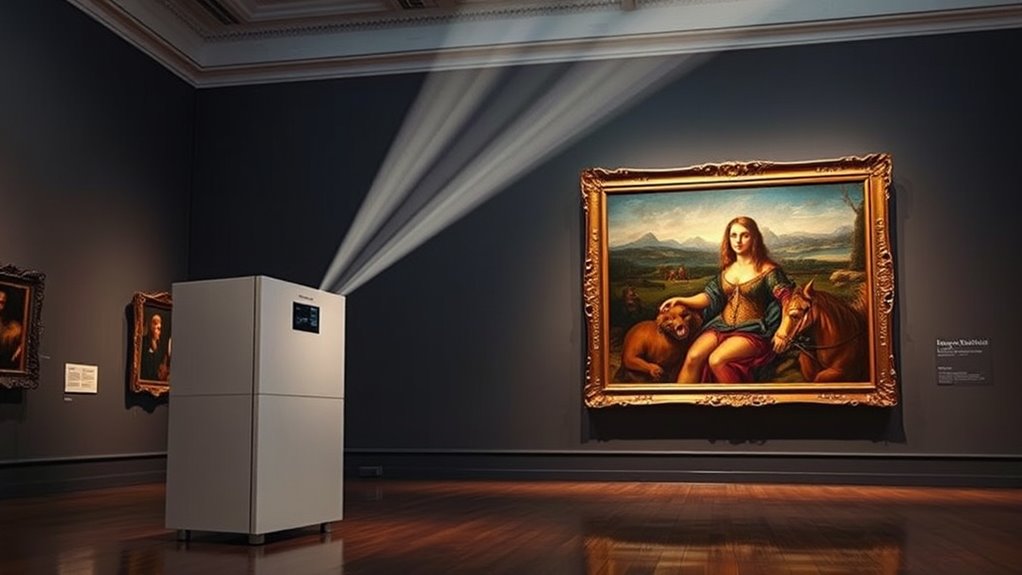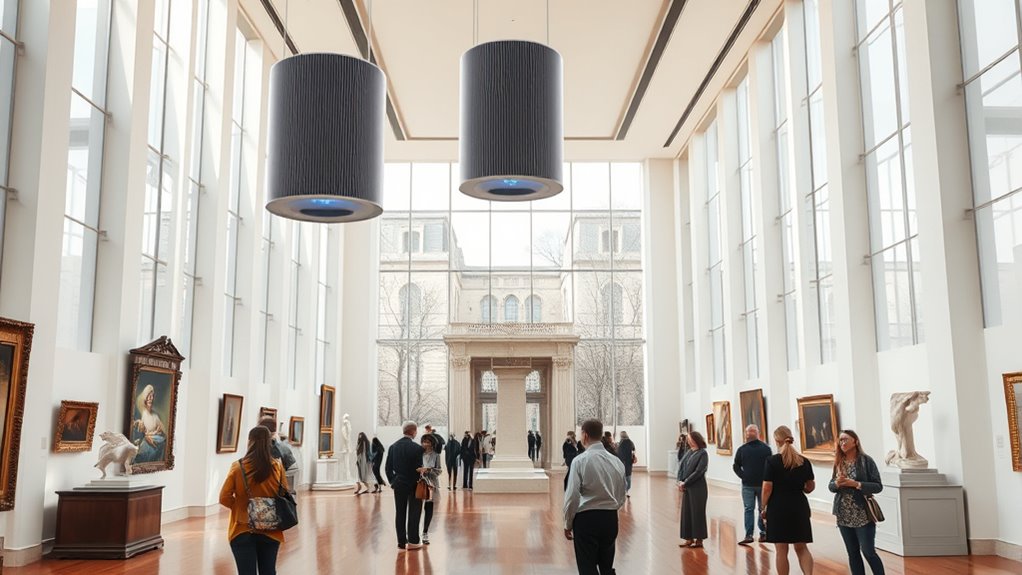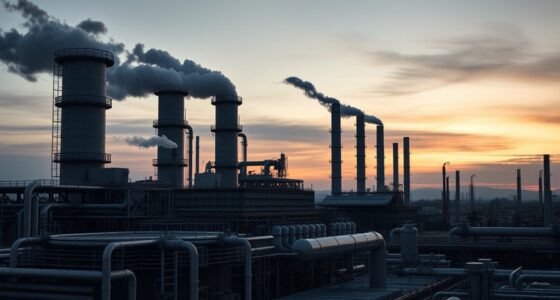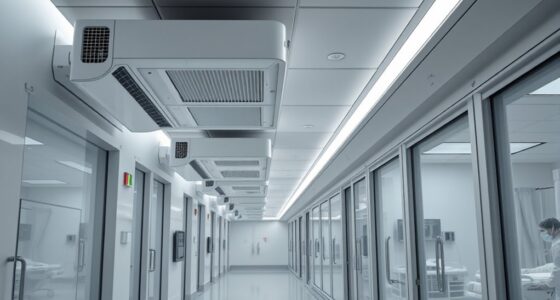In museums and galleries, effective air purification is essential to protect your valuable artworks and ensure visitor safety. By filtering out dust, pollen, VOCs, and airborne pollutants, air purification systems help maintain a clean environment and reduce the risk of deterioration caused by pollutants and humidity fluctuations. Limiting visitor numbers also supports cleaner air quality. If you want to know how these systems work together for maximum preservation, keep exploring the key strategies behind a secure, healthy space.
Key Takeaways
- Air filtration systems eliminate dust, pollen, and airborne pollutants to protect delicate artworks and ensure a clean environment for visitors.
- Controlling humidity levels prevents mold growth, cracking, and warping of artworks, preserving their integrity over time.
- Limiting visitor capacity reduces pollutant influx from clothing fibers, footwear, and breathing, maintaining optimal air quality.
- An integrated environment management approach combines humidity control and air filtration for comprehensive protection of collections.
- Continuous air quality monitoring and purification support the longevity of artworks and ensure a safe, healthy space for visitors.

Have you ever wondered how museums and galleries protect priceless artworks from airborne pollutants? It’s a crucial part of preservation that often goes unnoticed. One key factor is humidity control, which plays a vital role in maintaining the integrity of delicate pieces. Fluctuating humidity levels can cause materials like paper, canvas, and wood to expand or contract, leading to cracks, warping, or mold growth. By using advanced climate control systems, institutions keep humidity consistently within ideal ranges, reducing stress on artworks. This not only prolongs their lifespan but also preserves their original appearance and structural stability. Proper humidity control also prevents the buildup of dust and other airborne particles that can settle on surfaces and cause deterioration over time.
Humidity control prevents damage by stabilizing delicate materials and reducing airborne dust in museums and galleries.
Another essential aspect is managing visitor capacity. Museums and galleries are designed to welcome the public, but large crowds can inadvertently introduce pollutants through increased breathing, clothing fibers, and even footwear. Higher visitor capacity often correlates with increased air pollution levels inside the space, which can accelerate the degradation of sensitive artworks. To counter this, facilities monitor and regulate the number of visitors allowed at any given time, ensuring that the air remains as clean as possible. Limiting capacity helps reduce airborne pollutants and allows the air purification systems to operate more effectively. When fewer visitors are present, air filtration units can work at optimal efficiency, continuously removing dust, pollen, and other harmful particles.
Combining humidity control with visitor capacity management creates a balanced environment that protects both the artworks and the visitors. By maintaining stable humidity levels, galleries prevent damage caused by moisture fluctuations, while controlling the number of visitors minimizes the introduction of pollutants. This integrated approach also enhances the overall visitor experience, as a cleaner, more stable environment feels more welcoming and professional. Modern air purification systems are often integrated with these controls, ensuring a consistent quality of air throughout the museum or gallery. These systems actively filter out airborne pollutants, including volatile organic compounds (VOCs), which can be emitted by certain materials or cleaning agents, further safeguarding priceless collections.
In essence, protecting artworks from airborne pollutants isn’t just about installing air purifiers; it’s about creating an environment where humidity is carefully managed and visitor numbers are controlled. This comprehensive strategy preserves the integrity of the art and ensures a safe, enjoyable experience for visitors. By understanding and implementing these measures, museums and galleries uphold their mission of safeguarding cultural treasures for generations to come. Proper air quality management plays a critical role in maintaining the longevity of valuable collections.
Frequently Asked Questions
How Do Air Purifiers Affect Humidity Levels in Museums?
Air purifiers can affect humidity levels depending on their type. For example, HEPA filters primarily remove particles without impacting humidity, while some air purifiers with humidifying or dehumidifying features actively control humidity. If you use a purifier with humidity control, it helps maintain ideal levels, protecting art and visitors. Choose the right air purifier type to balance air quality and humidity, ensuring a stable environment in your museum or gallery.
Are There Eco-Friendly Air Purification Options Suitable for Galleries?
You’ll find eco-friendly air purification options that are like a gust of fresh air for galleries. Using eco friendly filters and natural purification methods, such as plant-based filters or activated charcoal, you can keep the air clean while protecting the environment. These solutions not only reduce your carbon footprint but also create a healthier space for visitors and artwork alike. It’s a win-win for sustainability and preservation.
What Maintenance Is Required for Museum Air Purification Systems?
You need to regularly maintain your museum’s air purification system by performing system calibration to guarantee peak performance. Additionally, you should replace filters according to the manufacturer’s recommendations, typically every few months. Keep an eye on system indicators and schedule routine inspections to prevent dust buildup and maintain air quality. Proper maintenance helps protect your artwork and visitors, ensuring the system functions efficiently and sustainably.
Can Air Purifiers Eliminate All Types of Airborne Pollutants?
In the age of the great explorers, you’d think air purifiers could conquer all. Sadly, they can’t eliminate every pollutant type; purification limitations exist. While they effectively reduce dust, VOCs, and microbes, some gases and ultrafine particles slip through. You need multiple filtration layers and proper maintenance to maximize their efficiency. Relying solely on air purifiers won’t guarantee complete removal of all airborne pollutants, so thorough environmental controls are essential.
How Do Air Purification Standards Vary Internationally for Museums?
International standards for air purification in museums vary, but they all prioritize maintaining high air quality to protect art and visitors. You’ll find guidelines set by organizations like ISO and ASHRAE, which specify acceptable pollutant levels and filtration methods. While standards differ slightly across countries, the goal remains consistent: guarantee ideal air quality by controlling airborne pollutants, allergens, and particulates, creating a safe, preserved environment for both artwork and visitors.
Conclusion
So, while you focus on admiring priceless art, the very air around it may be quietly eroding its beauty. Ironically, the same efforts to preserve masterpieces might be overlooked as you breathe in polluted air. Proper air purification isn’t just about comfort—it’s about safeguarding history itself, even when we least realize it. Next time you visit, remember, behind every stunning piece is a silent guardian fighting the invisible enemy. Protecting art means protecting your experience—don’t let pollution steal the show.









